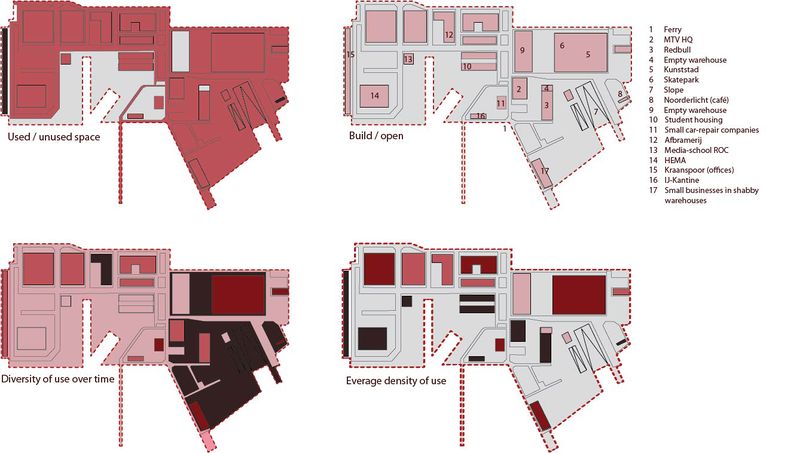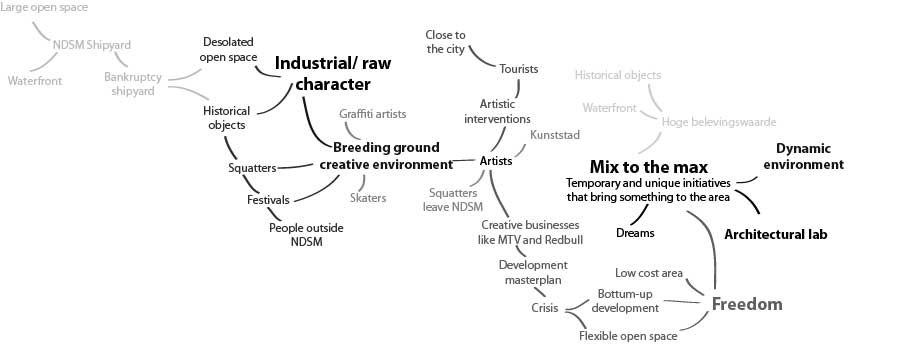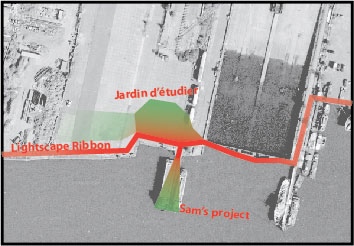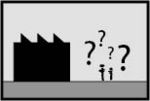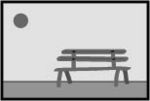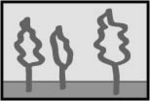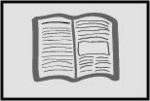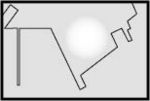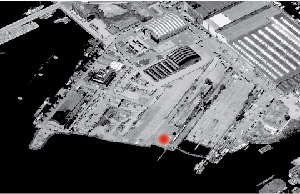project11:NDSM
Contents |
Short history of NDSM-wharf
The MSc1 design project is situated in the North of Amsterdam. In this area you can find the old NDSM warf, established on the riverbanks of the IJ. This odd part of the city has an extensive and complex history, although relatively short.
Since the Dutch shipbuilding company NSM moved to the site in 1915, it has always been a world on its own. The IJ harbor forms a physical barrier between the famous city centre and the NDSM area, which is named after the Dutch dock and shipbuilding company NDSM, that was created when the companies NSM and NDM decided to merge. In 1937 it became the biggest shipyard in the world. In 1984, 37 years later, the shipbuilding company was declared bankrupt. This turned the wharf into a spectacular location with plenty of open space next to the water, filled with abandoned halls, warehouses, docks and cranes.
Over the years, a lot of those big warehouses have been squatted. The place attracted artist and musicians. They started using the empty space by organizing cultural festivals, like Robodock. As the place became a bit more commercial over time, the original squatters left the place. But a trend was set, the place kept attracting young artist and a foundation named ‘Kinetisch Noord’ was astablished. In one of the warehouses the foundation has developed the Kunststad (Art city), a ‘breeding place’ were young artist and designers can create their own ateliers and workspaces. MTV pushed out the last original squatters and made their headquarters at the docks in 2007. More artist, music festivals and galleries have followed since.
Bron:
http://online.wsj.com/articl/SB10001424052702304569504576405690067730056.html#articleTabs=article
http://www.ndsm-werfmuseum.nl/
Existing site
Compared to the built environment on the NDSM-terrain, there is a large amount of open space. The open space can be used in many differentways, like eventspaces. This is a unique feature from the site if you consider its geographical location in Amsterdam. Some old warehouses are transformed into creative corporates and an artists hub is created. These buildings are spread out over the area. The large distance between the objects results into isolation of functions.
Organic growth NDSM
This diagram shows the organic growth of the character of NDSM over time. Each aspect is influenced by another aspect and will, in time, influence the ecosystem by itself. Every initiative brings something to the site, but it also poses a treat or opportunity to the ecosystem.
View on the ecosystem of NDSM
When you first enter the site, it might look abanded, but wait a moment and absurb the energy that is flowing throw this area. It has become an incredible dynamic environment where a lot of things happen, but most importantly, an area where a lot of thing can happen. NDSM is about dreams and human size. Dreams become initiatives and can get explored on this site. It grows in an organic way, made by people for people, through consultation and discussion. These bottom-up approaches are typical for this area and create a unique mix of activities on the site. It's about taking and providing. Each user can explore the site and use it in a spontaneous way. Every initiative will bring something to the site. In this way, an ecosystem is created. The squatters created the first festivals, the festivals created an energetic environment, in combination with the industrial character of the site it attracted different artists, who in their turn contributed to the creative environment that later attracted big creative corporations like MTV and Redbull.
The site becomes interactive when a new initiative comes in. New activities grow onto the site when they are demanded or dreamed of. Every initiative will bring something to the site, but it can also replaces (parts of) excisting features. In time, this will change the way people use the area. On the NDSM-terrain these shiftings in character are following eachother in a rapid speed. This makes the area so flexible and dynamic. The amount of open space and the freedom on the site is very unique if you consider the geographical location. For some reason, big masterplans have not gained ground yet on NDSM. It might has something to do with the bad connection or maybe with the crisis, it might even be that the municipality acknowledge the special qualities the site can bring to the city. Either way, the lack of top-down management has turned this site into a big architectural lab, where the unexpected happens.
Existing ecosystem NDSM
Although a site's ecosystem contains a lot of different aspects (like circulation, activities, money flows etc.), the most important aspect is people. The users of a space create connections and cohesion. There are multiple kind of users on NDSM.
1. Employees. They don't feel connected to the site, due to the lack of fascilities that the can use. There is no need for them to stay on NDSM, so they leave at 5pm.
2. Artists. The artists have a strong connection to the site. They like the industrial character and are sceptic to new investments, due to a fear of loosing the existing environment. The artist bring a lot to the site. They create a creative environment where dreams can be realised. On the other hand, the community is quite closed, so it is hard to sense this energy if you're just passing by.
3. Tourists. The tourists (even the dutch ones) are attracted by the creative atmosfeer and the adventure of discovering this odd site. They want to explore the area, especially when there is an event or attraction. On a average workday, they don't feel invited to the area. It's hard to understand what is going on due to the lake of information. All activities are hidden behind closed walls.
4. By-passers. People that only need to cross the area to travel from the ferry to another destination don't have a clue what is going on on the site. They don't sense the creative atmosfeer or energy.
5. Residents. Residents often don't chose to live on NDSM because of the site qualities. They are able to live on the site because of the low rent, but they would rather live somewhere else, due to the lack of fascilities on the site.
There is one thing that most users have in common: they have a specific activity on the site. NDSM fails to engage people further then there enitial intent. This is due to the distance between activities and the unused public space inbetween. Improving those aspects of the site will increase the way people can explore the site and that will make NDSM more vivid.
Developed ecosystem NDSM
Problems and opportunities
This project aims to respond to an extracted selection of problems and opportunities of the NDSM-ecosystem.
|
Closed character of NDSM Users are intended to use NDSM like a playground. They can explore the place and discover its variety of creative initiatives. Only in most cases, this doen't work out. People don't often go to NDSM without any purpose. Their visits always have a clear focus. Al activities are isolated in their own enclosure. The don't provide anything for unintended users, like by-passers or tourists. This makes it hard to know what is going on inside the big warehouses. The buildings don't invite new participants in the area. |
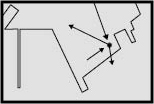 |
Shared facilities Students will be able to use different facilities from other initiatives; including a fablab (project 05) and different workshops (project 14) and a skate park (project 03). |
Chosen site
|
Although the design aims to enhance the character of the site by making a lively atmosphere, the shosen site lies a bit away from the other buildings. This is done for two reasons: 1. To minimalize the negative impact on the existing ecosystem. The designs aims to create a more dynamic and lively atmosphere, but it might be that the existing users like their own quite life, hidden in there closed buildings. 2. To create an optimal learning environment, with views over the water and minimal disturbtion from other activities (because of the distance). A fysical connection will be made with project 14 and will be expressed by a transition space from land to water. The shared activity will be a mediatheque, but the connection with land is also made by a small café. |
Site Visit
10-02-2012 - I walked around in the NDSM area with Sam van Til. Together we've tagged some objects:
and people:
- Architect - Björn van Rheenen
- Project Engineer - Sander Buijs
MTV baliemedewerkster - existing TAG?
We've done an very usefull interview with architect Björn van Rheenen.
Our talk with Sander Buijs was also inspiring.


